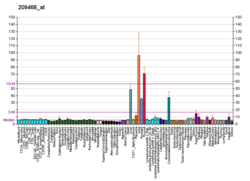Clinical significance
The Wnt signaling pathway was first linked to bone development when a loss-of-function mutation in LRP5 was found to cause osteoporosis-pseudoglioma syndrome. [22] Shortly thereafter, two studies reported that gain-of-function mutations in LRP5 caused high bone mass. [23] [24] Many bone density related diseases are caused by mutations in the LRP5 gene. There is controversy whether bone grows through Lrp5 through bone or the intestine. [25] The majority of the current data supports the concept that bone mass is controlled by LRP5 through the osteocytes. [26] Mice with the same Lrp5 gain-of-function mutations also have high bone mass. [27] The high bone mass is maintained when the mutation only occurs in limbs or in cells of the osteoblastic lineage. [17] Bone mechanotransduction occurs through Lrp5 [28] and is suppressed if Lrp5 is removed in only osteocytes. [29] There are promising osteoporosis clinical trials targeting sclerostin, an osteocyte-specific protein which inhibits Wnt signaling by binding to Lrp5. [26] [30] An alternative model that has been verified in mice and in humans is that Lrp5 controls bone formation by inhibiting expression of TPH1, the rate-limiting biosynthetic enzyme for serotonin, a molecule that regulates bone formation, in enterochromaffin cells of the duodenum [11] [12] [13] [14] [15] [16] and that excess plasma serotonin leads to inhibition in bone. Another study found that a different Tph1-inhibitor decreased serotonin levels in the blood and intestine, but did not affect bone mass or markers of bone formation. [17]
LRP5 may be essential for the development of retinal vasculature, and may play a role in capillary maturation. [31] Mutations in this gene also cause familial exudative vitreoretinopathy. [7]
A glial-derived extracellular ligand, Norrin, acts on a transmembrane receptor, Frizzled4, a coreceptor, Lrp5, and an auxiliary membrane protein, TSPAN12, on the surface of developing endothelial cells to control a transcriptional program that regulates endothelial growth and maturation. [32]
LRP5 knockout in mice led to increased plasma cholesterol levels on a high-fat diet because of the decreased hepatic clearance of chylomicron remnants. When fed a normal diet, LRP5-deficient mice showed a markedly impaired glucose tolerance with marked reduction in intracellular ATP and Ca2+ in response to glucose, and impairment in glucose-induced insulin secretion. IP3 production in response to glucose was also reduced in LRP5—islets possibly caused by a marked reduction of various transcripts for genes involved in glucose sensing in LRP5—islets. LRP5-deficient islets lacked the Wnt-3a-stimulated insulin secretion. These data suggest that WntLRP5 signaling contributes to the glucose-induced insulin secretion in the islets. [33]
In osteoarthritic chondrocytes the Wnt/beta-catenin pathway is activated with a significant up-regulation of beta-catenin mRNA expression. LRP5 mRNA and protein expression are also significantly up-regulated in osteoarthritic cartilage compared to normal cartilage, and LRP5 mRNA expression was further increased by vitamin D. Blocking LRP5 expression using siRNA against LRP5 resulted in a significant decrease in MMP13 mRNA and protein expressions. The catabolic role of LRP5 appears to be mediated by the Wnt/beta-catenin pathway in human osteoarthritis. [34]
The polyphenol curcumin increases the mRNA expression of LRP5. [35]
Mutations in LRP5 cause polycystic liver disease. [36]
This page is based on this
Wikipedia article Text is available under the
CC BY-SA 4.0 license; additional terms may apply.
Images, videos and audio are available under their respective licenses.





